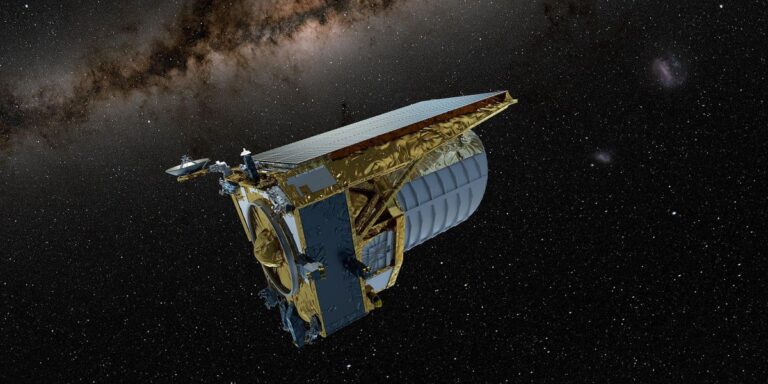For nearly a century, the mystery of our crazy dark universe has puzzled both theorists and astronomers alike. Let’s face it, even with the best telescopes, what is visible on any given clear night represents only a small fraction of the universe as we understand it.
Dark matter —- which makes up some 20 percent of the cosmos —- neither emits nor absorbs light but gravitationally attracts normal matter. Dark energy —- responsible for the inexplicable acceleration of our expanding universe —- makes up a whopping 76 percent of our cosmos. Normal matter, the stuff of flesh and bone and stars and planets, represents less than four percent of the known cosmos.
The hope is that we will soon know much more about this dark realm.
Next month’s launch of the European Space Agency’s (ESA) Euclid Mission, with infrared detectors provided by NASA, should give new clues as to the physical nature of both dark matter and dark energy. No one expects the 1.2-meter telescope mission to answer everything, but it should give theorists a wealth of new data to chew on.
Why is this telescope so special?
Euclid will map large-scale structure over cosmic time covering the last 10 billion years, says ESA. In the process, it will image 1.5 billion galaxies with Hubble Space Telescope-like resolution while taking spectroscopic redshift data on some 50 million galaxies, says the agency.
It has two science instruments, one that uses visible light and one that uses infrared light, U.S. Euclid science lead Jason Rhodes, an observational cosmologist at NASA JPL, told me via email. There is an optical element called a ‘dichroic’ that splits incoming light into visible and infrared components and sends those components to the appropriate instrument, says Rhodes. Both instruments also contain cameras with a huge number of pixels and both can observe the sky and gather data at the same time, he says.
Assuming a normal launch in July, Euclid’s nominal six-year science mission will begin this December from L2, a gravitationally stable Earth-Sun position about a million miles from Earth. Euclid will cover 15,000 square degrees of sky. It will produce a very large atlas with enormous resolution in both visible and near infrared wavelengths.
What’s the biggest technical challenge that Euclid will face?
Dark energy studies are statistical in nature, says Rhodes. If there is even a slight systematic offset to those shapes or distances, it can bias our results, he says. This is what prompted us to want to use a space telescope, above Earth’s atmosphere, for these measurements, says Rhodes.
The hope is that Euclid will shrink the error bars of current measurements, possibly ruling out wide classes of potential causes of the accelerating expansion, Rhodes notes. Ruling out these potential explanations brings us closer to understanding the physical cause of dark energy, he says.
The crux of Euclid’s measurements involves a one-two punch. First the spacecraft will measure how galaxies are affected by dark matter, then it will use those measurements to better characterize dark energy.
From the galaxy shapes, you see that it has been distorted a bit due to dark matter, Rene Laureijs, the Euclid Project Scientist at ESA ESTEC in The Netherlands, recently told me in his office. And from the distribution of dark matter, you can derive the accelerating expansion, says Laureijs.
Our understanding of Galaxy clustering is so good now that we can pin down the dark energy content of the universe, University of Oslo theoretical physicist Hans Winther, a Euclid science consortium team member, recently told me in his office. So, independent of distance measurements to Type 1a supernovae, we have massive evidence for the acceleration of the universe, says Winther.
How does dark energy affect the large-scale structure of the universe?
We’re trying to understand what dark energy is by studying large scale structure of the universe, says Winther. When you study structure formation, there are basically just two things that you care about —- gravity, the attraction of stuff; and the expansion of the universe, he says. It’s basically a battle between those two, says Winther.
In 1917, before our observational understanding of big bang theory and the cosmos’ universal expansion, Einstein temporarily added his so-called cosmological constant (a repulsive force) to his theory of general relativity. He did so to adhere to the theory of a static universe, in order to counter gravity’s effects on ordinary matter. Einstein quickly retracted this aspect of his field equations once there was observational evidence of an expanding universe, known as the Hubble expansion.
But by the late 1990s, theorists had resurrected Einstein’s cosmological constant as a repulsive force of quantum mechanics known as vacuum energy, background energy embedded in spacetime itself. That’s when, in 1997 and 1998, two Nobel Prize-winning teams determined that some five to seven billion years after the big bang our cosmos had inexplicably begun accelerating its expansion.
Theorists in the current era latched onto the cosmological constant as somewhat of an ad hoc fix to explain the force behind dark energy. Arguably, it seems only a temporary solution until we better understand the physical nature of dark energy. Or perhaps, the universe does have vacuum energy in the fabric of space time that is somehow causing this acceleration. But why did dark energy’s accelerating force only kick in five to seven billion years after the big bang?
How is the cosmological constant’s value calculated?
It’s the value that we measure to explain how much dark energy or how much cosmological constant we should have in our universe nowadays, University of Oslo theoretical physicist David Mota, a Euclid science consortium team member, recently told me in his office. There’s a big discrepancy between the value that we calculate from particle physics and the value that we observe astronomically, says Mota. When you do the calculations, this energy in the vacuum is up to 120 times larger than the value that we measure from observations, he notes.
As for which dark theory represents the biggest puzzle?
“My money is on dark energy because we know even less about it than dark matter, but it is an even bigger component of the universe,” said Rhodes. “In the distant past, dark energy was an inconsequentially small component of the universe.”
But in the future, dark energy will dominate, and dark matter will be a much smaller component, says Rhodes. The nature of dark energy will also determine the fate of the universe, he notes.
Mota goes even further and asserts that all the theories used to define the cosmos as we currently understand it are likely wrong.
From Newton, we moved on to Einstein and the curvature of space and time, says Mota. But a million years from now, I hope humankind can evolve to embrace a different kind of mathematical and physical theories, he says. But at this stage, we are just taking baby steps, says Mota.
Read the full article here








